Thank you for contacting us.
We will reply by email as soon as possible.
Please click the button to continue:
We will reply by email as soon as possible.
Please click the button to continue:
click to close popup
Welcome to biophotonics, the photonics of life…
Biophotonics is an emerging scientific field that focuses on our understanding of life processes by interpreting the language of biophoton emission, the light generated by all living organisms. The role of MELUNA in this exciting new science, lies in active research and conceptual development, as well as in our technological expertise. Following is a short introduction in biophotonics — click the button below for technical details and some in-depth information on key concepts. To read more on MELUNA and its input and output on biophotonics, please choose a section from the menu.
Photonics as a light-based optical technology, has been hailed as one of the dominant scientific applications for the third millennium. In utilizing photons instead of electrons, photonics has achieved tremendous gains in data transfer rates and information processing.
As an extension of photonics, biophotonics covers research in the interaction between light and biological matter, with particular regard to the ultra-weak photon emission (UPE) that is endogenously produced in cells, organs and organisms, and with regard to delayed luminescence (DL). In a further analogy to photonics, growing evidence has demonstrated that such biophotons serve an essential function in biological information processing.
Recently, the unravelling of this biophoton functioning has become feasible due to the availability of cutting-edge technology, specifically ultra-sensitive photomultiplier tubes (PMT) and charge-coupled device (CCD) imaging systems. By combining the development of these advanced measurement tools with innovative analysis procedures, biophotonics has been able to open up a new “optical window” on the organization of living systems.
UPE, example image
Ultra-weak photon emission, dorsal side of the hand (click image to zoom).
This multidisciplinary approach has created major diagnostic opportunities in health research. As such, non-invasive photon recording and signal analysis has been implemented to detect a number of metabolic changes that correspond to the continuum from health to disease. An example is the diagnostic indication of early stages of type 2 diabetes. Also, biophoton-parameters show strong correlations with free radical reactions in tumor growth. Another promising research area relates to energy topics such as stress reduction, biological aging and vitality.
Vitality is a key concept in an additional example of MELUNA’s activities: the fruitful application of the biophotonics paradigm in the field of agriculture. UPE and DL parameters are predictive benchmarks of growth altitude and optimal vitality as a quality of agricultural products, and were found to correlate with herbal classification according to therapeutic properties.
In this second section of our introductory chapter on A New Science of Light, we will outline a functional specification of some of the components of the photomultiplier tube (PMT), the main measurement tool utilized in biophotonics. Also provided below, is more in-depth information on some of the key concepts that are in involved in theorization and experimentation in biophotonics.
As for the type of light radiated, spontaneous ultra-weak photon emission (UPE) is low-intensity and non-thermal light, with wavelengths typically within the spectral range of 300–750 nm (UV and UV/VIS), depending on the system observed. Rate of photon emission generally lies in the order of 101–103 photons·s−1·cm−2. Not requiring stimulation from an external source, the endogenous origin of UPE lies in oxidative metabolic reactions — biophotons are therefore closely related to the generation of e.g. reactive oxygen species (ROS). When perturbed, such reactions may give rise to excessive amounts of ROS, causing multiple types of organic damage.
Advanced analysis of a number of UPE parameters has resulted in effective and validated tools for the detection of a variety of physiological conditions and dynamic changes in state of health. For instance, a test based on fractal properties of the UPE signal accurately predicts different subtypes of pre-diabetes. Also, using quantum optics calculations of squeezed state parameters, UPE analysis proves to be a valuable test instrument in determining organic allostatic stress states and corresponding vitality related variables. As a corollary, such an analysis indicates the level of a person’s experience with stress-reduction techniques such as meditation.
To read more on evidence-based health research conducted by MELUNA, please click here.
In contrast to UPE, Delayed Luminescence (DL) is a decaying photon emission in reaction to stimulation induced by exposure to an external light source. The main difference between DL and fluorescence as a more generally known type of luminescence, lies in the time of decay of the excited state, with DL referring to light that fades in milliseconds to seconds.
Since a biological system is characterized by its unique DL buildup and decay properties, DL has been utilized as a sensitive indicator for the chemical and physiological state of such systems.
The application of DL based tools has yielded promising results in the area of agricultural product screening and control. For more information on MELUNA projects in this field, please click here.
Optical detection methods in biophotonics rely heavily on photomultiplier tubes (PMT): a sophisticated photosensor module that is known for its particularly high sensitivity. Following, is a concise explanation of the essential components and functioning of the Photomultiplier Tube.
Photomultiplier Tube
Schematic illustration of the principal PMT components (click image to zoom).
Photomultiplier Tube
Schematic illustration of the principal PMT components (click image to zoom).
The principle of the PMT is based on an evacuated glass tube with a transparent window that allows photons to hit the primary photocathode component, which will emit electrons when thus illuminated. In the sensor-construction and located behind the photocathode, the second electrode, a dynode, has a slightly more positive voltage than the cathode. This potential difference creates an electric field that draws the electrons liberated from the photocathode, until they hit the dynode, thereby liberating “secondary” electrons.
Following this, the process will repeat itself at a series of dynodes with consecutively more positive potentials, that are sequentially located in the PMT.
This process will result in a continuous multiplication of the number of liberated electrons. For example: with an electron multiplication per stage of about 10, the liberation of one single electron from the photocathode will have produced 108 electrons at stage 8.
By then, signal strength is considered large enough to be detected with standard electronics and can be amplified into a measurable pulse, the outcome of which is displayed by a counter.
Grain quality plays a crucial role in the food industry, but determining it is often time-consuming and labor-intensive. To address these challenges, the GRaiNNOVATE project officially launched at the end of 2024. This cross-border initiative, funded by Interreg Detuschland-Nederland, focuses on developing innovative technology to assess grain quality faster and more efficiently.
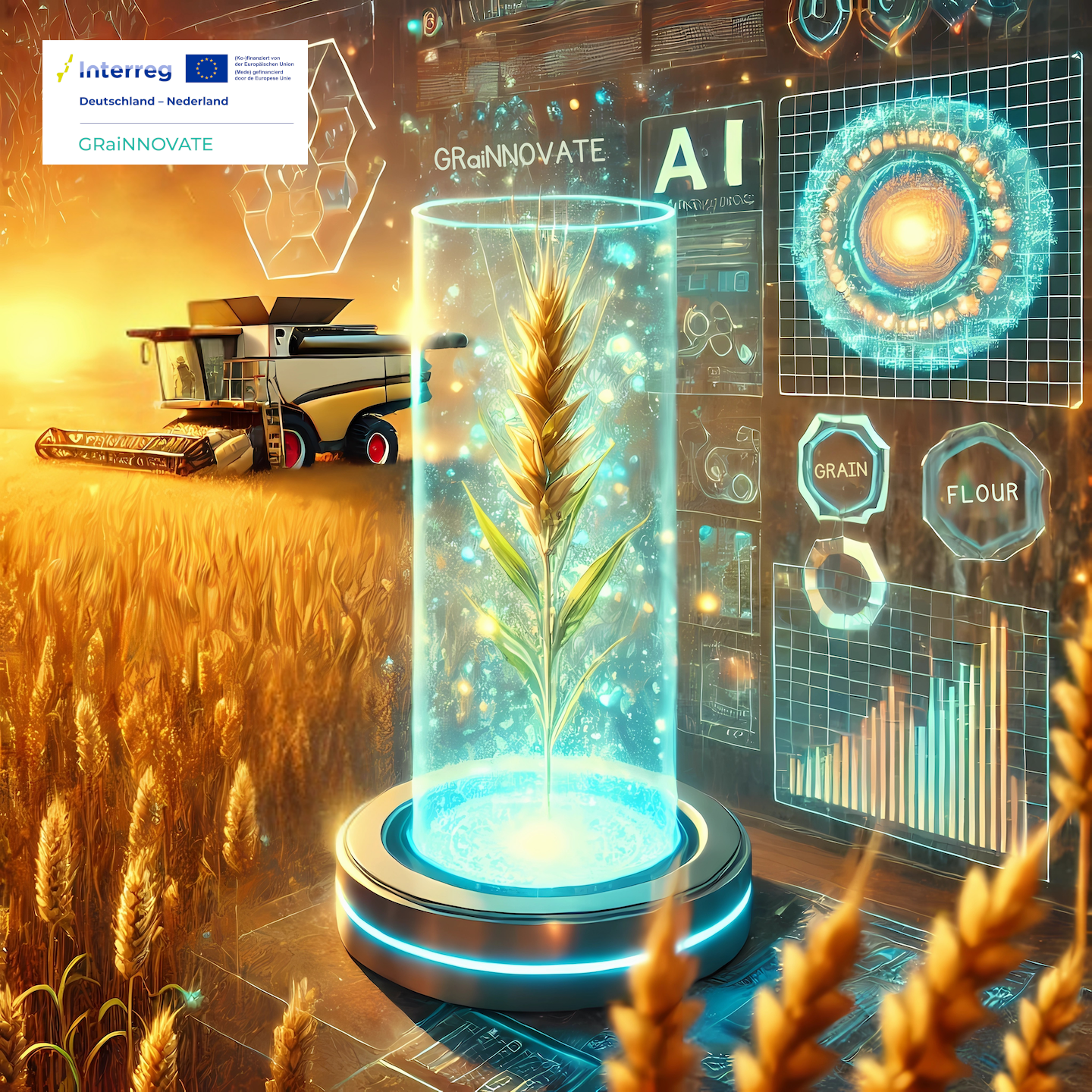
Project GRaiNNOVATE
A Faster and More Sustainable Way to Measure Grain Quality
Traditional methods for determining grain quality often require significant time, specialized equipment, and skilled personnel, leading to inefficiencies in production. GRaiNNOVATE aims to develop a sustainable and accurate analysis method that not only shortens the turnaround time for quality checks but also helps reduce resource waste and costs within the grain and flour supply chain. Within the project, various partners from the Netherlands and Germany are collaborating to develop SMS4Grain (Smart Multi-sensor System for Grain). This advanced device uses spectroscopic methods, biophotonics, and artificial intelligence (AI) to measure key quality parameters within minutes, such as falling number, protein and gluten content, moisture levels. Thanks to this innovative technology, companies in the grain and flour supply chain can make faster and more efficient decisions. The goal of the GRaiNNOVATE project is to advance the SMS4Grain from prototype to a market-ready product within two and a half years.
Cross-border Collaboration
The GRaiNNOVATE project brings together experts from various sectors to realize this technology. The collaboration includes leading companies and research institutions from the Netherlands and Germany:
Lead Partner (NL):
• Meluna Research B.V. (Gelderland)
Project Partners (DE):
• Aspectus GmbH (North Rhine-Westphalia)
• Plange GmbH (North Rhine-Westphalia)
• Rheinland Technologie GmbH (North Rhine-Westphalia)
Research Institution:
• Jheronimus Academy of Data Science (JADS) (Formally represented by Eindhoven University of Technology) (North Brabant, NL)
Additionally, the project is supported by nine associated partners contributing to further development and implementation.
Interreg Funding and Project Duration
The GRaiNNOVATE project runs from November 2024 to April 2027, with a total budget of €1,914,453.10. The funding is provided by Interreg VI Deutschland-Nederland, in collaboration with:
• The Dutch Ministry of Economic Affairs
• The Ministry of Economic Affairs, Industry, Climate Protection, and Energy of the State of North Rhine-Westphalia (DE)
• The Provinces of Gelderland and North Brabant (NL)
Project GRaiNNOVATE is carried out within the framework of the Interreg VI Deutschland-Nederland program and is co-financed by the European Union, the Dutch Ministry of Economic Affairs, the Ministry of Economic Affairs, Industry, Climate Protection, and Energy of the State of North Rhine-Westphalia, and the Provinces of Gelderland and North Brabant.
Stay Informed
Would you like to stay up to date on the progress of the GRaiNNOVATE project? Follow us via our website and social media channels!
Drawing on more than 30 years of experience in biophotonic research and development, MELUNA offers services that include consultation on optimal experimental designs, as well as the assembly and validation of custom-built UPE and DL measurement equipment, both hardware and software. Listed below, is a selection of relevant research projects that attest to our expertise. These projects link to the collaboration section of our site. The first button below links to two MELUNA products as an example of our work in the application of biophotonics. For additional information about our services, please click the contact-button.
UPE measurement of the hands demonstrates a high intensity emission and allows for an assessment of spatial symmetry related variables. Moreover, limiting UPE measurement to the hands results in no significant loss of information, since signal parameters at a specific body site reflect those of the overall body. Based on these findings, MELUNA has developed and validated mobile PMT devices: reliable and accurate measurement instruments for both research purposes as well as practical diagnostic screening in clinical offices. Furthermore, evidence has shown that hand UPE parameters provide useful indications that are predictive of organic relaxation-stress states. For in-depth analysis and detailed explication of this diagnostic information, MELUNA has developed the PASS® concept.
Table top PMT device
Schematic illustration of
the main components.
Designed and constructed by MELUNA, the mobile photomultiplier device comes equipped with two sensitive PMTs, allowing for a simultaneous UPE recording of both hands. Both PMT’s open to separate dark chambers, with electronically synchronized shutters placed between each chamber and the opening of the corresponding PMT. Also, both channels of the counter card are triggered by the same timer, ensuring the simultaneous photon counting of both hands.
As for the material used, the container case owes its extreme rigidity to its metal construction. Prevention of light leakage is further improved by the application of specially constructed metal contacts. Operating in ambient room temperature will not reduce the sensitivity of the selected sensors, which allows for a convenient use in clinical settings and research environments.
PMT model PCS-DH
Seperate container cases,
to increase versatility
(click image to zoom).
Located at the front side of the container case, two openings allow for the insertion of the hands. To prevent light leakage from these insertion openings, specially constructed light tight gloves are utilized that fit and close around the elbow.
Recording the dorsal or palm side of the (dark adapted) hands generally takes about 3 minutes, with background photon counts measured directly before the actual UPE recording. After completion of the measurements, data are immediately processed, utilizing special software developed to determine: UPE strength, Fano factor, Squeezed State properties of the photon signal, and left-right symmetry.
To facilitate even more mobility and convenience in experimental settings and clinical offices, PMT model PCS-DH was developed (model depicted in image), which comes with a seperate container case per dark chamber.
When absorbed in a variety of biological molecules, cells, and tissues, photons generally induce transitions between electronic states, thereby producing physical effects within living organisms, effects that result in secondary radiation. In considering the health-disease continuum, the characteristics of such photon emissions have been shown to contain significant diagnostic information, in particular with respect to early indications of systematic effects of allostatic stress load on the organization of metabolic reactions.
Based on findings from UPE research in this field of strain, stress and coping (both physiological and psychological), MELUNA has constructed an advanced functional diagnostic tool for the assessment of relevant photon signal parameters: the PASS® analysis system, acronym for Personal Accumulated Stress Structure. In recent years, a combination of MELUNA PMT model hardware and PASS® software has been tested and validated as a tool for providing UPE analysis of stress and vitality related variables. Click here for a recent publication on this research.
Compared to the regular biochemical approach, photon profiling has the advantage of being a non-invasive diagnostic tool for allostasis. As an additional advantage, outcomes are obtained almost instantly.
In the general analysis mode, the PASS® software compares the photon signal parameters of each measurement site to a database of related statistical values, after which the parameters will be assigned a weighted percentage score depending on measurement site, age and sex of the subject.
PASS® offers the option to represent these weighted percentage outcomes in a bar code structure. The barcode is a statistical graphical profile type that allows for the simultaneous depiction of multiple photonic properties in a manner that is both informative and fully quantified. In the example figure, the PASS® parameters have been rendered illegible to protect legal reproduction rights of MELUNA.
PASS® profile example (click image to zoom)
PASS® bar code profile of the photonic properties of a subject. The preview above shows the list of parameters of the right hand palm (RP). For the complete profile image including measurement data and other hand sites, click the preview.
PASS® profile example (click image to zoom)
PASS® bar code profile of the photonic properties of a subject. The preview above shows the list of parameters of the right hand palm (RP). For the complete profile image including measurement data and other hand sites, click the preview.
To provide an overview of our UPE and DL research projects, the section below presents a selection of references to scientific publications, both in the field of human health and in agricultural science. Recent MELUNA publications regarding the health-disease continuum contribute groundbreaking proof of concept on the use of UPE information in the diagnosis of human stress-related effects. In agricultural science, MELUNA has applied the biophotonics paradigm in a number of studies on the screening and control of optimal vitality as a quality of agricultural products, in maximizing seed germination, and in explorative studies on UPE and DL correlates of medicinal herbs.
The challenging technological and methodological complexities of research in biophotonics call for an effective interdisciplinary involvement of chemists, physicists, biologists, engineers, and healthcare professionals. Participating in this integrated approach, MELUNA has taken an active role in pioneering studies and in the articulation of new conceptual perspectives and methodologies, both in the field of human health and in the agricultural sciences. Listed below, is an overview of collaborative research projects in which MELUNA has teamed up with international research partners. The concept of a multidisciplinary network implies however, that professional education in biophotonics lacks a specific established academic framework. Publishing essential textbooks on biophotonics is one of the contributions of MELUNA to the advancement of such an educational context. Furthermore, in collaboration with the Sino-Dutch Centre for Preventive and Personalized Medicine, we have committed ourselves to take part in promoting and improving educational opportunities that will shape the biophotonics of the future.
Emerging within a research network, biophotonics integrates insights and methods from multiple scientific disciplines in creating knowledge that crosses traditional boundaries. As promising as it may sound, such interdisciplinarity brings with it the absence of localized establishments, that is: academic departments or institutes that are specifically dedicated to science education in biophotonics. To improve this situation and contribute to an advanced education in biophotonics, MELUNA organises educational activities such as workshops, lectures, and summerschools. Furthermore, MELUNA offers Ph.D. research opportunities and project supervision. For recent dissertations of our Ph.D. students, see the list below. In addition to its educational activities, MELUNA publishes textbooks on research topics in biophotonics that provide a much needed learning resource.
In addition to rigorous scientific studies in peer-reviewed journals, MELUNA is contributing to the existing body of knowledge on biophotonics through the publication of essential interdisciplinary textbooks. These publications provide a learning resource that covers both innovative conceptual perspectives and methodologies, as well as in-depth analysis of current research and experimentation. By providing these books, MELUNA aims to further advance education in key topics of biophotonics for a new generation of researchers and medical professionals. Find out more — abstracts and further information will be listed below.
Roeland van Wijk
Publisher: MELUNA, 2014
Foreword written by:
John Ackerman
ISBN-13:
9789081884327
Link to online sales for international customers (Amazon.com). Dutch customers can order the book from all Dutch (online) bookstores.
[ Excerpt from back cover —]
The production of biological light (ultra-weak photon emission or biophotons) within cells and tissues is characteristic of an alive organism. The reader starts on journey of discovery about biophotons in relationship to biological matter and about how such biophotons can be detected utilizing specialized very photon-sensitive technologies.
In this book, Roeland Van Wijk provides a unified synthesis that facilitates easy entry into an exciting sub-field of biology. Light in Shaping Life encompasses the history of biophoton research, insight into how biophotons are generated, and into their involvement with life. Also included, is an overview of the potential benefits of such research to a better understanding of health and medicine.
Roeland van Wijk,
Yu Yan,
Eduard P.A. van Wijk
Publisher: MELUNA, 2018
ISBN-13:
9789081884341
Link to online sales for international customers (Amazon.com). Dutch customers can order the book from all Dutch (online) bookstores.
[ Excerpt from back cover —]
Biophoton Technology in Energy and Vitality Diagnostics opens a new window in the fascinating mystery of life and vitality. The endogenuous metabolic dance of biophotons and matter is recorded by the light that escapes from our body. In recent times many aspects of this dance are elucidated both from the perspective of the molecules and from the perspective of energy.
Biophoton Technology in Energy and Vitality Diagnostics helps in shifting your mind-set. It brings together the most advanced metabolic approaches in molecular cell biology and most modern methodologies of studying the human photon emission. Health care professionals interested in vitality will learn the new systems biology approach (from molecule to society) and how vitality is measurable using human photon energy technology.
A spin-off company of the Faculty of Biology at the University of Utrecht, MELUNA — an acronym of: MEasurement of LUminescence in NAtural products — was founded in 1998 as an independent research institute with the bold mission to transform the life sciences (biology, agriculture, medicine) through the scientific exploration of biophoton properties. Today, MELUNA is considered a unique and valuable collaboration partner in the field of biophotonics. Visit our site for an impression of some groundbreaking experimentation in the field of agriculture and in the human health sciences, or for discovering valuable instrumental applications and educational opportunities in biophotonics. Or find out about the consultation services on methodology and about the custom-built biophoton measurement equipment provided by MELUNA, and more… Listed below, is a short profile of our scientific personnel.
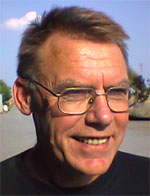
Roeland van Wijk
Dr. Roeland Van Wijk has a background in Biology and is specialized in Physical Science (Biophysical Chemistry). He was affiliated as Associate Professor in Molecular Cell Biology at the Utrecht University until his retirement.
Currently, Roeland is scientific director of MELUNA Research and research advisor of The Sino-Dutch Centre for Preventive and Personalized Medicine.
He authored more than 350 scientific papers on topics in stress biology and biophotonics.

Eduard van Wijk
Dr. Eduard Van Wijk has a background in Cognitive and Biological Psychology. In 1999, he was affiliated as senior researcher at the International Institute of Biophysics and later at the Leiden University (Leiden Academic Center for Drug Research, Division of Analytical BioSciences).
Currently, Eduard is affiliated with MELUNA Research with a responsibility for the topic biophotonics in relation to health (lifestyle) and disease. He is co-founder of The Sino-Dutch Centre for Preventive and Personalized Medicine, The Netherlands.
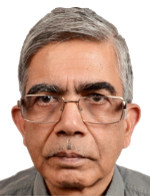
Rajendra Bajpai
Rajendra Bajpai Rajendra’s profile can be found on Linkedin. Weblink: Rajendra Bajpai on linkedin.
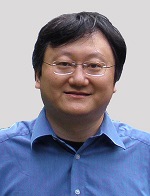
Yu Yan
Dr. Yu Yan finished his study in Biology at Hangzhou University, China and obtained his Ph.D. degree at University Mainz in Germany. After his study, he worked in the field of biophoton research and biophotonics.
In 2009, Yu Yan joined MELUNA Research. He specializes in the department of biophotonics, NIR, Raman and UVVIS spectroscopy, and is a key researcher for the development of new measurement technologies.
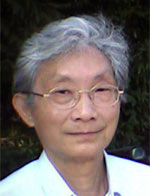
Zhongchen Yan
Zhongchen Yan finished his undergraduate and graduate study in electronics at the elite Chinese Tsinghua University. After his study, he worked at universities and institutes in Hangzhou, China. His working fields include integrated circuit technology (IC), automatic control and computer technology. From 1999 to 2009, he worked at the International Institute of Biophysics in Germany.
He continued his work at MELUNA Research, using his knowledge of electronics, mechanics and computer science in the development of new technologies to measure biophoton emission.
To contact us by email, please use the email-form.
Research and Development
Business & Science Park Wageningen, Agro Business Park 10
6708 PW Wageningen
The Netherlands
Administration
Weistraat 12
4196 JE Tricht
The Netherlands